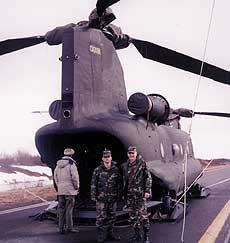ARCTIC MISSION: NOT IMPOSSIBLE
Five Army Veterinary Corps officers trained with more than 150 other medical personnel, including physicians, nurses, and dentists, in the frigid environment of Alaska for the last two weeks in March. Operation Arctic Care is a joint innovative readiness training exercise held each year involving the US Army and Army Reserve, US Navy Reserve, US Marine Reserve, the US Air Force, and the US Public Health Service. This was the fourth consecutive year of the exercise in which medical, dental, and veterinary care was provided to remote villages in the Bristol Bay region of southwest Alaska. The Army Veterinary Corps officers were Maj Terry Gosch, Maj Craig Carter, Capt William B. Finney, Capt Garry O'Neal, and Capt Kimberly Whitten.

Headquarters for the operation was established at the King Salmon Air Force Base in King Salmon, Alaska. From there, the veterinary teams were shuttled from village to village by CH-47 Chinook helicopters and bush planes. Some small villages were accessible only by snowmobile. The 24 villages visited were scattered over a 46,000-square-mile area about the size of Ohio.
The four veterinary teams in the contingent carried out the primary mission of providing veterinary preventive medical care (vaccinations, deworming, and physical examinations) and teaching dog bite prevention classes to children and animal husbandry to adults, many of whom are active dogsled mushers.
The veterinary teams experienced harsh conditions, including total whiteout with blowing snow and minus 30 F temperatures with windchills to 70 below zero. Cold-weather gear was issued and worn by the teams to protect against frostbite. Because most of the animals reside outdoors all year, treatment also had to be given outdoors. In many instances, the weather was so cold that the vaccine would freeze before it could be injected into the animal.
The Bristol Bay Area Health Corporation is the sole provider of comprehensive health care services to the 29 villages in this region of Alaska comprising about 6,500 people. The veterinary team mission was well received by the villagers, as sled dogs provide viable transportation in this part of the state. Many mushers own 20 or more dogs.

Zoonotic diseases are a real concern for the Bristol Bay. Rabies is endemic in the arctic and in brown foxes. The domestic animal populations are, therefore, at risk and can pose a hazard to the people in the area. Hydatid disease is also found in the local populace. Raw caribou viscera are often eaten by domestic dogs that go on to develop the adult stage of the tapeworm Echinococcus granulosus. Eggs from these worms are shed via animal feces in the environment, and, when ingested by people, can develop into hydatid cysts, which are life threatening. Echinococcus multilocularis is a similar tapeworm in which the rodent participates in the lifecycle. Other zoonotic parasites in the environment include hookworms and roundworms. The medications administered by the veterinary teams during Operation Arctic Care greatly decrease the risk of zoonotic disease in native Alaskans in addition to protecting the health of the animals.
Injuries relating to animal bites are also a substantial problem in Alaska, especially with the children. Recently, a small child was killed as it wandered into a pen full of dogs. More than 750 children attended bite prevention classes taught in village schools by the veterinary teams. The incidence of dog bite wounds in children in this region has decreased dramatically since Operation Arctic Care was launched four years ago.
An additional mission objective was suggested and planned this year by Major Carter, who is head of epidemiology and informatics at the Texas Veterinary Medical Diagnostic Laboratories. Reviewing the veterinary medical literature, he discovered little reported on the prevalence of diseases in domestic dogs in Alaska. He proposed that veterinary teams perform a baseline sero-epidemiologic study while working in the remote villages. Blood was obtained from 70 dogs and 53 fecal specimens were collected from animals in 24 villages. Testing is under way to determine what possible zoonotic and other agents the dog population has been exposed to. The final results of the study will be made available to local health officials. It is hoped that this study will spur more in-depth work in future missions.